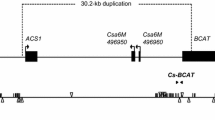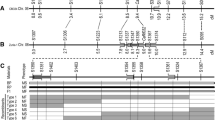Abstract
Key message
A major QTL conditioning high degree of femaleness in cucumber was identified by marker analysis and next generation sequencing.
Abstract
Cucumber (Cucumis sativus L.) is a model species for sex determination studies, and its yield is associated with the degree of femaleness. Subgynoecy represents a sex form with a high degree of femaleness for which the genetic basis remains elusive. In this study, genetic analysis in the F2 and BC1 populations developed from a cross between subgynoecious S-2-98 and monoecious M95 suggested a quantitative nature of subgynoecy. Application of simple sequence repeat markers between subgynoecious and monoecious bulks constructed from BC1 plants identified three QTLs: sg3.1, sg6.1, and sg6.2. The major QTL sg3.1 contributed to 54.6 % of the phenotypic variation, and its presence was confirmed by genome-wide comparison of SNP profiles between parental lines and a subgynoecious bulk constructed from BC6 plants. Using PCR-based markers developed from the SNP profile, sg3.1 was further delimited to a genomic region of 799 kb. The genetic basis of subgynoecy revealed here shall shed light on the development of elite cultivars with high yield potential.




Similar content being viewed by others
References
Abe A, Kosugi S, Yoshida K, Natsume S, Takagi H, Kanzaki H, Matsumura H, Yoshida K, Mitsuoka C, Tamiru M (2012) Genome sequencing reveals agronomically important loci in rice using MutMap. Nat Biotech 30:174–178
Byers R, Baker L, Sell H, Herner R, Dilley D (1972) Ethylene: a natural regulator of sex expression of Cucumis melo L. Proc Natl Acad Sci USA 69:717–720
Chen H, Tian Y, Lu X, Liu X (2011) The inheritance of two novel subgynoecious genes in cucumber (Cucumis sativus L.). Sci Hortic 127:464–467
Dorca Fornell C, Gregis V, Grandi V, Coupland G, Colombo L, Kater MM (2011) The Arabidopsis SOC1-like genes AGL42, AGL71 and AGL72 promote flowering in the shoot apical and axillary meristems. Plant J 67:1006–1017
Drews GN, Bowman JL, Meyerowitz EM (1991) Negative regulation of the Arabidopsis homeotic gene AGAMOUS by the APETALA2 product. Cell 65:991–1002
Fazio G, Staub J, Stevens M (2003) Genetic mapping and QTL analysis of horticultural traits in cucumber (Cucumis sativus L.) using recombinant inbred lines. Theor Appl Genet 107:864–874
Galun E (1962) Study of the inheritance of sex expression in the cucumber. The interaction of major genes with modifying genetic and non-genetic factors. Genetica 32:134–163
Huang S, Li R, Zhang Z, Li L, Gu X, Fan W, Lucas WJ, Wang X, Xie B, Ni P (2009) The genome of the cucumber, Cucumis sativus L. Nat Genet 41:1275–1281
Jansen RC (1993) Interval mapping of multiple quantitative trait loci. Genetics 135:205–211
Jansen RC, Stam P (1994) High resolution of quantitative traits into multiple loci via interval mapping. Genetics 136:1447–1455
Jofuku KD, Den Boer B, Van Montagu M, Okamuro JK (1994) Control of Arabidopsis flower and seed development by the homeotic gene APETALA2. Plant Cell 6:1211–1225
Knopf RR, Trebitsh T (2006) The female-specific Cs-ACS1G gene of cucumber. A case of gene duplication and recombination between the non-sex-specific 1-aminocyclopropane-1-carboxylate synthase gene and a branched-chain amino acid transaminase gene. Plant Cell Physiol 47:1217–1228
Kubicki B (1969) Investigations on sex determination in cucumber (Cucumis sativus L.). Genet Pol. 10:5–143
Kubicki B (1974) New sex types in cucumber and their uses in breeding work. In: Able ST (ed), XIX International Horticultural Congress 1974 September 11–18 Warszawa, pp 475–485
Lander ES, Botstein D (1989) Mapping mendelian factors underlying quantitative traits using RFLP linkage maps. Genetics 121:185–199
Lee J, Lee I (2010) Regulation and function of SOC1, a flowering pathway integrator. J Exp Bot 61:2247–2254
Lee S-Y, Hwang EY, Seok H-Y, Tarte VN, Jeong MS, Jang SB, Moon Y-H (2015) Arabidopsis AtERF71/HRE2 functions as transcriptional activator via cis-acting GCC box or DRE/CRT element and is involved in root development through regulation of root cell expansion. Plant Cell Rep 34:223–231
Li H, Durbin R (2009) Fast and accurate short read alignment with Burrows-Wheeler transform. Bioinformatics 25:1754–1760
Li Z, Pan J, Guan Y, Tao Q, He H, Si L, Cai R (2008) Development and fine mapping of three co-dominant SCAR markers linked to the M/m gene in the cucumber plant (Cucumis sativus L.). Theor Appl Genet 117:1253–1260
Li Z, Huang S, Liu S, Pan J, Zhang Z, Tao Q, Shi Q, Jia Z, Zhang W, Chen H (2009) Molecular isolation of the M gene suggests that a conserved-residue conversion induces the formation of bisexual flowers in cucumber plants. Genetics 182:1381–1385
Malepszy S, Niemirowicz-Szczytt K (1991) Sex determination in cucumber (Cucumis sativus L.) as a model system for molecular biology. Plant Sci 80:39–47
Mibus H, Tatlioglu T (2004) Molecular characterization and isolation of the F/f gene for femaleness in cucumber (Cucumis sativus L.). Theor Appl Genet 109:1669–1676
Nakano T, Suzuki K, Fujimura T, Shinshi H (2006) Genome-wide analysis of the ERF gene family in Arabidopsis and rice. Plant Physiol 140:411–432
Okamuro JK, Caster B, Villarroel R, Van Montagu M, Jofuku KD (1997) The AP2 domain of APETALA2 defines a large new family of DNA binding proteins in Arabidopsis. Proc Natl Acad Sci USA 94:7076–7081
Papadopoulou E, Little HA, Hammar SA, Grumet R (2005) Effect of modified endogenous ethylene production on sex expression, bisexual flower development and fruit production in melon (Cucumis melo L.). Sex Plant Reprod 18:131–142
Perl-Treves R (1999) Male to female conversion along the cucumber shoot: approaches to studying sex genes and floral development in Cucumis sativus. Bios Scientific Publishers, Oxford, pp 189–215
Pitrat M (1994) Gene list for Cucumis melo L. Cucurbit Genetic Coop Report 17:135–147
Rudich J, Halevy A, Kedar N (1972) Ethylene evolution from cucumber plants as related to sex expression. Plant Physiol 49:998–999
Saito S, Fujii N, Miyazawa Y, Yamasaki S, Matsuura S, Mizusawa H, Fujita Y, Takahashi H (2007) Correlation between development of female flower buds and expression of the CS-ACS2 gene in cucumber plants. J Exp Bot 58:2897–2907
Sakuma Y, Liu Q, Dubouzet JG, Abe H, Shinozaki K, Yamaguchi-Shinozaki K (2002) DNA-binding specificity of the ERF/AP2 domain of Arabidopsis DREBs, transcription factors involved in dehydration-and cold-inducible gene expression. Biochem Bioph Res Co 290:998–1009
Salman-Minkov A, Levi A, Wolf S, Trebitsh T (2008) ACC synthase genes are polymorphic in watermelon (Citrullus spp.) and differentially expressed in flowers and in response to auxin and gibberellin. Plant Cell Physiol 49:740–750
Shiber A, Gaur R, Rimon-Knopf R, Zelcer A, Trebitsh T, Pitrat M (2008) The origin and mode of function of the female locus in cucumber. Cucurbitaceae 2008:263–270
Shifriss O (1961) Sex control in cucumbers. J Hered 52:5–12
Takagi H, Abe A, Yoshida K, Kosugi S, Natsume S, Mitsuoka C, Uemura A, Utsushi H, Tamiru M, Takuno S (2013) QTL-seq: rapid mapping of quantitative trait loci in rice by whole genome resequencing of DNA from two bulked populations. Plant J 74:174–183
Takahashi H, Jaffe M (1983) Further studies of auxin and ACC induced feminization in the cucumber plant using ethylene inhibitors. Phyton 44:81–86
Trebitsh T, Rudich J, Riov J (1987) Auxin, biosynthesis of ethylene and sex expression in cucumber (Cucumis sativus). Plant Growth Regul 5:105–113
Trebitsh T, Staub JE, O’Neill SD (1997) Identification of a 1-aminocyclopropane-1-carboxylic acid synthase gene linked to the female (F) locus that enhances female sex expression in cucumber. Plant Physiol 113:987–995
Van Ooijen J (2006) JoinMap 4. Software for the calculation of genetic linkage maps in experimental populations. Kyazma BV, Wageningen
Yamasaki S, Fujii N, Takahashi H (2003) Characterization of ethylene effects on sex determination in cucumber plants. Sex Plant Reprod 16:103–111
Yin T, Quinn JA (1995) Tests of a mechanistic model of one hormone regulating both sexes in Cucumis sativus (Cucurbitaceae). Am J Bot 82:1537–1546
Yuan X, Pan J, Cai R, Guan Y, Liu L, Zhang W, Li Z, He H, Zhang C, Si L (2008) Genetic mapping and QTL analysis of fruit and flower related traits in cucumber (Cucumis sativus L.) using recombinant inbred lines. Euphytica 164:473–491
Zhang Z, Mao L, Chen H, Bu F, Li G, Sun J, Li S, Sun H, Jiao C, Blakely R (2015) Genome-wide mapping of structural variations reveals a copy number variant that determines reproductive morphology in cucumber. Plant Cell 114:135848
Acknowledgments
We thank Dr. Yiqun Weng and Arjan van Zeijl for their help with revising the manuscript and Tao Lin for his help with SNP profiling. This study was funded by the National Natural Science Foundation of China (NSFC: 31225025), the National Program on Key Basic Research Projects in China (The 973 Program: 2012CB113900), the National High Tech Research Development Program in China (The 863 Program: 2010AA10A108, 2012AA100101), and the Chinese Ministry of Finance (1251610601001).
Author information
Authors and Affiliations
Corresponding author
Ethics declarations
Conflict of interest
The authors declare that they have no conflict of interest.
Ethical standards
The authors declare that all experiments described in this manuscript comply with the current laws in China.
Additional information
Communicated by H. J. van Eck.
F. Bu, H. Chen and Q. Shi contributed equally.
Electronic supplementary material
Below is the link to the electronic supplementary material.
Rights and permissions
About this article
Cite this article
Bu, F., Chen, H., Shi, Q. et al. A major quantitative trait locus conferring subgynoecy in cucumber. Theor Appl Genet 129, 97–104 (2016). https://doi.org/10.1007/s00122-015-2612-z
Received:
Accepted:
Published:
Issue Date:
DOI: https://doi.org/10.1007/s00122-015-2612-z




